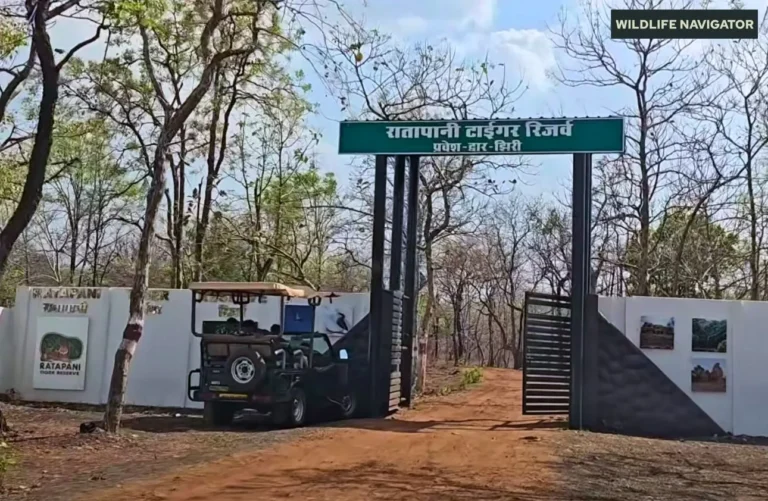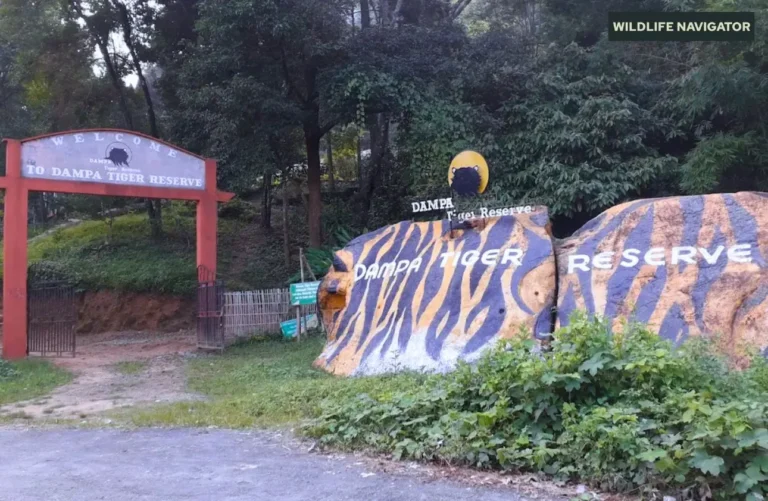Blackbuck National Park – Velavadar

Blackbuck National Park, also known as Velavadar National Park, is one of India’s most unique protected landscapes, located in the Bhavnagar district of Gujarat. Spread across vast, golden grasslands and bordered by the Gulf of Khambhat, this park is a rare and pristine ecosystem dedicated to conserving the graceful blackbuck antelope. Unlike dense forest reserves, Velavadar offers open savannah-like plains, giving visitors spectacular, unobstructed views of wildlife in motion.
This park is particularly renowned for hosting one of the largest populations of blackbucks in India. Watching male blackbucks with striking spiralled horns engage in territorial displays and high-speed chases across the grasslands is a signature experience here. The park is also globally recognised for being one of the world’s largest roosting sites for harriers, attracting raptor enthusiasts and birdwatchers from around the world.
With its serene atmosphere, rich biodiversity, and dramatic sunrise and sunset landscapes, Blackbuck National Park offers a rare chance to witness India’s fast-vanishing grassland ecosystem. It is a prime destination for wildlife lovers, photographers, birdwatchers, and travellers seeking an offbeat and peaceful nature experience.
History and Establishment
Originally part of the private grassland hunting grounds of the Maharaja of Bhavnagar, the area that is today Blackbuck National Park once served as a royal reserve. Recognising the ecological value of the region and the need to protect its dwindling blackbuck population, the government designated it a protected area in 1969.
In 1976, it was officially declared a national park, covering approximately 34 sq km. Over time, the park was further expanded to include adjoining wetlands and grasslands, enhancing habitat diversity.
The park stands as one of India’s most significant efforts to conserve grassland wildlife, especially species like the blackbuck and the Indian wolf. While forests dominate India’s conservation narrative, Velavadar highlights the importance of safeguarding grassland ecosystems, which are among the most threatened habitats in the country.
Its establishment marked an important shift in recognising and protecting open plains and savannah-like environments, making it a model for grassland conservation in India.
Landscape and Habitat
Blackbuck National Park features one of India’s most remarkable grassland ecosystems, often compared to the African savannah for its wide, open plains and sweeping horizon views. The core of the park is dominated by tall and short grass species, which create an ideal habitat for grazing antelopes and predators that rely on open visibility for hunting.
To the south, the park transitions into low-lying saline flats known as bannis, which temporarily hold water during the monsoon and dry out in summer, offering a unique seasonal landscape. On the eastern side lies the Gulf of Khambhat, where coastal marshes and mudflats serve as feeding grounds for migratory waterbirds and flamingos. This blend of grassland, scrub, wetland, and coastal ecosystem makes Velavadar exceptionally rich in biodiversity despite its relatively small size.
Seasonal changes dramatically transform the park’s appearance—lush green during the monsoon, golden and dry in winter, and stark but striking in summer. These shifts influence animal movement and photography opportunities, making each season visually distinct. The vast openness and stillness create a peaceful atmosphere, offering visitors an immersive natural experience rarely found in other Indian wildlife parks.
Wildlife of Blackbuck National Park
Blackbuck National Park is a stronghold of grassland species and open-habitat predators. The park supports diverse fauna adapted to semi-arid plains, wetlands, and coastal zones.
Blackbuck National Park (Flagship Species)
- Large herds visible across open grasslands
- Males with distinctive corkscrew horns and dark-and-white coat
- Courtship, territorial fights, and sprinting displays common
Other Mammals
- Indian wolf – apex predator of the grasslands
- Striped hyena – scavenger and nocturnal predator
- Golden jackal – commonly sighted in grassland belts
- Nilgai (Blue bull) – largest Asian antelope
- Wild boar
- Indian hare
- Jungle cat
Birdlife (Major Highlight)
- Harriers – including Montagu’s, Pallid, and Marsh Harrier; world’s largest communal winter roost
- Larks, pipits, and wheatears – grassland specialists
- Flamingos and pelicans – in coastal wetlands
- Storks, cranes, egrets, herons – seasonal wetland visitors
- Raptors – eagles, kestrels, buzzards, falcons
Reptiles
- Monitor lizard
- Indian cobra
- Russell’s viper
- Saw-scaled viper
- Tortoise species (occasional sightings)
The combination of large herbivore herds, apex predators, and migratory birds makes Velavadar one of India’s most productive grassland ecosystems.
Best Time to Visit
Blackbuck National Park is open year-round except during the peak monsoon, but wildlife viewing quality varies by season.
Ideal Season
- November to March
- Pleasant temperatures
- Maximum blackbuck and predator sightings
- Peak harrier migration period
- Best conditions for photography (golden light, clear skies)
Summer (April to June)
- Very hot, harsh sun
- Wildlife gathers around water sources, offering good sightings
- Grass is shorter, improving visibility
Monsoon (July to October)
- Park typically remains closed during heavy monsoon period
- Landscape turns green and lush
- Limited wildlife access but excellent habitat regeneration phase
Safari and Visitor Experience
Blackbuck National Park offers a peaceful and immersive wildlife experience, focused on slow observation rather than crowded safari tourism.
Safari Timings
- Safaris are conducted during fixed morning and evening hours
- Entry typically allowed after sunrise and before sunset
- Timing varies seasonally, aligned with daylight hours
Entry & Permits
- Visitors must obtain permits at the park gate
- Private vehicles allowed in designated routes (with permit)
- Forest department vehicles available on limited basis
- ID proof required for entry formalities
Safari Style
- Open grassland viewing rather than dense-forest tracking
- Wildlife easily visible due to wide landscapes
- Best enjoyed with binoculars and long-range lenses
Photography Tips
- Morning light creates dramatic golden tones in grasslands
- Sunset silhouettes of blackbucks are iconic here
- Use telephoto for action shots and wide-angle for landscapes
- Avoid loud noise or sudden movement to prevent disturbance
Experience Highlights
- Watching herds of blackbucks sprint across plains
- Spotting Indian wolves during dawn and dusk hours
- Observing massive harrier roosts in winter
- Peaceful, quiet environment ideal for birdwatching and nature study
The park’s calm, open terrain offers a unique safari style rooted in patience, minimal disturbance, and appreciation of grassland wildlife behaviour.
How to Reach
Blackbuck National Park is located near Velavadar village in the Bhavnagar district of Gujarat, well-connected by road, rail, and air.
Nearest Airport
- Bhavnagar Airport – approx. 50 km
- Regular flights from major Indian cities (via Mumbai/Ahmedabad)
Nearest Railway Station
- Bhavnagar Terminus (BVC) – approx. 45 km
- Connected to Ahmedabad, Surat, Vadodara, Mumbai (via major junctions)
Road Connectivity
- Bhavnagar – 45 km
- Ahmedabad – approx. 150 km
- Vadodara – approx. 200 km
- Rajkot – approx. 175 km
Frequent buses and private taxis are available from Bhavnagar, Ahmedabad, and nearby cities.
Accommodation Options
Limited but comfortable stay options are available around Blackbuck National Park, ensuring a peaceful nature-centric visit.
Inside/Adjacent to the Park
- Blackbuck Lodge (luxury eco-stay)
- Cottages overlooking the grasslands
- Popular among wildlife photographers and naturalists
- Forest Department Guest House (Velavadar)
- Basic accommodation
- Requires advance booking through Gujarat Forest Department
Nearby Towns
- Bhavnagar (45 km)
- Business hotels and budget stays
- Vallabhipur
- Small lodges and homestays
- Private Farm-Stays
- Rural hospitality and local cuisine
- Quiet atmosphere close to nature
Booking Tips
- Winter season sees high demand by birdwatchers and photographers; advance booking is recommended
- Staying close to the park offers easier early morning and sunset safari access
Accommodation around Velavadar focuses on nature immersion rather than crowded resort-style tourism, ideal for peaceful wildlife experiences.
Visitor Guidelines, Conservation Significance, and Travel Tips
Blackbuck National Park promotes ethical, low-impact wildlife tourism to protect its fragile grassland ecosystem. Visitors are expected to follow basic etiquette to ensure animal safety and preserve natural behaviour.
Visitor Guidelines
- Maintain silence and avoid sudden movement
- Keep a safe distance from wildlife; do not chase animals
- No littering, feeding wildlife, or getting off permitted routes
- Respect photography ethics; avoid flash and disturbance
- Follow park timings and instructions from forest staff
Conservation Significance
- Key refuge for India’s blackbuck population
- Crucial habitat for endangered Indian wolves and grassland predators
- One of the world’s largest harrier roosting sites
- Protects a rare and threatened grassland biome, often overshadowed by forest conservation
- Eco-tourism supports local communities and park management
Travel Tips
- Carry binoculars, a telephoto lens, and extra batteries
- Sun protection essential (hat, sunscreen, sunglasses)
- Pack water and light snacks; minimal facilities inside the park
- Best explored during morning and evening drives
- Suggested duration: 1–2 days for wildlife viewing and photography
This combined section emphasises responsible travel while highlighting the park’s ecological value and offering practical planning advice for an optimal visit.
Conclusion
Blackbuck National Park stands as one of India’s finest grassland habitats, offering an experience unlike the dense jungles or mountainous sanctuaries found elsewhere in the country. Its vast open plains, thriving herds of blackbucks, winter roosts of harriers, and elusive predators like the Indian wolf make it a destination of high ecological and photographic importance.
A visit to Velavadar is not just a wildlife trip but an opportunity to understand and appreciate India’s lesser-known grassland ecosystems, which are among the most threatened habitats. Travellers who seek quiet landscapes, unique animal behaviour, and immersive nature moments will find this park deeply rewarding. Responsible visitation ensures that this rare ecosystem continues to thrive, preserving its wildlife heritage for the future.





